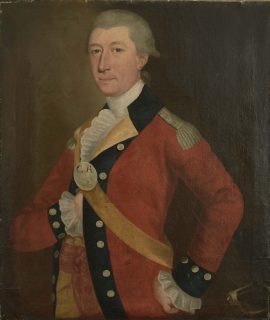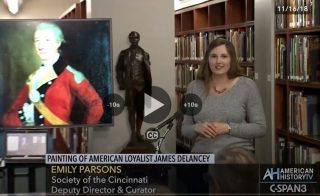
James DeLancey (1757-1804) was a member of one of the wealthiest and most influential families of eighteenth-century New York. He was the grandson of a Huguenot immigrant named Stephen DeLancey, who made his fortune as a merchant. Stephen’s children and grandchildren were important landowners on Manhattan and in the surrounding region and occupied important posts in provincial government. They included Stephen’s son James (1703-1760) and the latter’s son James (1732-1800). They were the uncle and cousin of the James DeLancey portrayed here, who was the son of Stephen’s son Peter (1705-1770). James inherited extensive landholdings in Westchester County from his father, along with property on Manhattan.
Prominent members of the DeLancey family opposed the Stamp Act and other efforts to tax the colonies, but they refused to support armed insurrection against the Crown and were loyalists during the Revolutionary War. James was high sheriff of Westchester County when the war began. In March 1777, he assumed command of the loyal militia of the county. By the fall, Colonel DeLancey was the commander of the Westchester Refugees, a mixed corps of about five hundred infantry and light horse, including many loyalists who had been driven from their homes or had their property confiscated by patriots.
DeLancey and his men operated chiefly in Westchester County, an area of small farms between the lines from which both sides drew supplies. DeLancey’s men collected forage and provisions for the British army, protected the critical post at Kings Bridge, took prisoners for exchange, captured British deserters and protected loyal residents and their property. The Refugees were particularly effective at collecting cattle to feed the British army, and were widely known as DeLancey’s Cowboys.
The struggle for control of the Neutral Ground involved continuous sparring, raids and reprisals by both sides, in which DeLancey and his men earned a reputation for toughness. The Refugees fought in some forty skirmishes and battles under DeLancey’s command, including a May 1781 raid on a Continental outpost on the Croton River, in which the Refugees killed Col. Christopher Greene and killed, wounded or captured scores of men from Greene’s First Rhode Island Regiment, a unit comprised mainly of African American soldiers. DeLancey was named in the New York Act of Attainder in 1779 and his property was confiscated. He resigned his commission in April 1783 and shortly thereafter sailed for London to press his claim for compensation. In September 1784 he sailed for Nova Scotia, where he joined other loyalist refugees.
This oil-on-canvas portrait of James DeLancey is one of the few surviving portraits of a loyalist officer in uniform painted in America during the war. DeLancey probably posed for it in New York City sometime between 1778 and 1782. He wears the uniform of his unit, which was adapted from the traditional uniform of the New York colonial militia. The two silver epaulets denote his rank as colonel. A light cavalry saber rests on the table at lower right. The portrait was probably painted by John Durand, an itinerant artist who worked in America from about 1767 until at least 1782. An obscure figure, Durand was probably born in London and apprenticed to a painter there before settling in New York. He was working in New York during the war and this portrait is consistent with his mature style. The treatment of the clothing is flat and linear with plain saturated colors—a characteristic of Durand’s work—while the face and its pleasing smile reflect the more confident skill of the artist’s later work.
Learn More About this Painting
Watch the Institute’s curator, Emily Schulz Parsons, present a thirty-minute talk on its portrait of American loyalist James DeLancey.
Watch the Institute’s curator, Emily Schulz Parsons, present a thirty-minute talk on its portrait of American loyalist James DeLancey.
